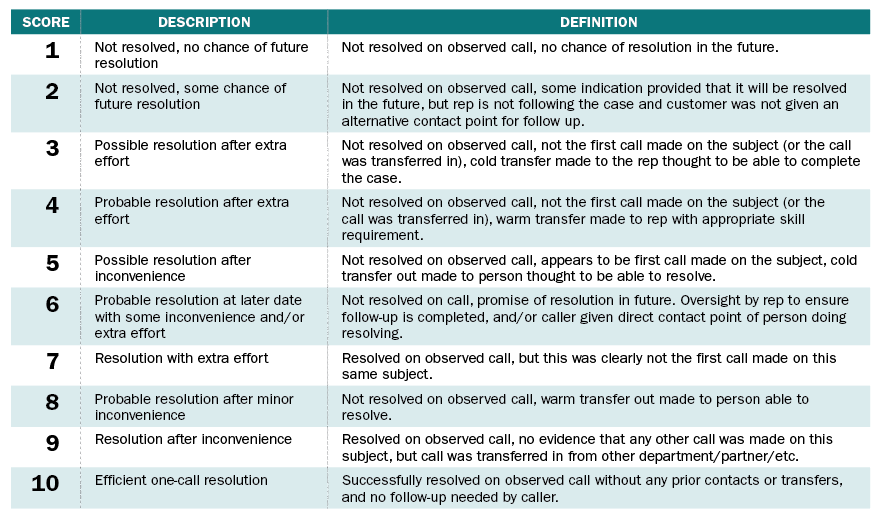Measuring FCR is not always black and white. Add an FCR scoring matrix to cover those calls that fall into the gray area.
No customer ever picked up the phone, dialed up a company and said, “Boy, I hope that they’re not able to help me today, and I have to call back to get my issue resolved.” First-call resolution (FCR), or one-and-done as it is sometimes called, is part of a small handful of expectations that we know applies to each and every caller who chooses to contact us.
And so most contact centers at least attempt to measure FCR. It is a bit tricky since the definition is subjective and varying scoring methodologies are employed. Despite these inconsistencies, every approach that I have seen eventually places the call in one of two buckets—FCR was either achieved for the contact, or it wasn’t. And while that black-and-white approach may make for clean scoring, it does not in any way reflect all the nuances involved in resolving a customer’s issue.
The Shallow Ends of FCR
In some cases, FCR truly is simple to evaluate. A customer calls in for what appears to be the first time on an issue, he/she gets everything fully addressed without any need to transfer the call, and the customer is not heard from on this topic ever again. Yes, we can all agree this meets the definition of FCR. Or the customer calls in, explains the situation and the need, and receives the dreaded, “I’m sorry, I can’t help you with that. You need to call the accounting department. Here’s their number.” We should all agree that this is in no way first-call resolution.
From live call observations that I’ve made on consulting assignments, those two extremes described above cover maybe half of all contacts. Thankfully, the successful FCR cases are the majority of that half. But what about the other 50%? That’s an awfully large chunk of calls that fall into a gray area. With our black-and-white approach to scoring, someone is making some dangerous assumptions about these calls that may or may not be true. And quite frankly, FCR is too important to leave to chance.
A Deeper Dive for Clarity
There are a few key questions that muddle up the FCR scoring mechanism. Does it appear (either through contact records or comments made by the customer) that this is not the first call on the topic? Was everything truly handled to completion, or is a future contact imminent? Did the call have to get transferred, and if so, was is it a warm or cold transfer? Is a follow-up required, and will that outbound call/contact be done by the rep or will we just assume that another department will complete the case? Every contact center, and indeed every customer, will have varying opinions on how the answers to the above questions impact first-contact resolution.
Instead of trying to guess at how customers view these complications, why not reflect these nuances in our FCR scoring? Maybe you are right in thinking that a call warm-transferred to the right resource still counts as FCR. But even if that’s true, any customer will tell you it is not as satisfying (or efficient) as having the first rep handle the call through to completion. Scoring each of these scenarios the same way is inherently flawed, but the good news is that flaw can be fixed.
The FCR Matrix
You monitor a statistically valid sample of calls, and you use that to provide valuable feedback to your representatives. Why not go a step further and add an FCR scoring matrix to that form? Below is the table that I use every time I observe calls in a contact center:

Summary
Consider the FCR matrix a guideline, and customize as needed for your environment. Once you’ve got it adjusted to your liking and you are generating data, you will be surprised at how effective it can be at identifying soft spots in your call-handling processes. You’ll begin to implement slight changes that turn twos into sixes and threes into eights. It’s those changes that will transform your customer satisfaction and loyalty scores from middle-of-the-pack to emerging leader.